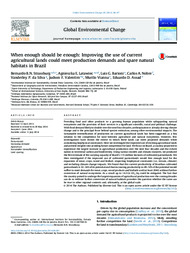When enough should be enough: improving the use of current agricultural lands could meet production demands and spare natural habitats in Brazil.
When enough should be enough: improving the use of current agricultural lands could meet production demands and spare natural habitats in Brazil.
Author(s): STRASSBURG, B. B. N.; LATAWIEC, A. E.; BARIONI, L. G.; NOBRE, C. A.; PORFIRIO-DA-SILVA, V.; VALENTIM, J. F.; VIANNA, M.; ASSAD, E. D.
Summary: Providing food and other products to a growing human population while safeguarding natural ecosystems and the provision of their services is a significant scientific, social and political challenge. With food demand likely to double over the next four decades, anthropization is already driving climate change and is the principal force behind species extinction, among other environmental impacts. The sustainable intensification of production on current agricultural lands has been suggested as a key solution to the competition for land between agriculture and natural ecosystems. However, few investigations have shown the extent to which these lands can meet projected demands while considering biophysical constraints. Here we investigate the improved use of existing agricultural lands and present insights into avoiding future competition for land. We focus on Brazil, a country projected to experience the largest increase in agricultural production over the next four decades and the richest nation in terrestrial carbon and biodiversity. Using various models and climatic datasets, we produced the first estimate of the carrying capacity of Brazil´s 115 million hectares of cultivated pasturelands. We then investigated if the improved use of cultivated pasturelands would free enough land for the expansion of meat, crops, wood and biofuel, respecting biophysical constraints (i.e., terrain, climate) and including climate change impacts. We found that the current productivity of Brazilian cultivated pasturelands is 32-34% of its potential and that increasing productivity to 49-52% of the potential would suffice to meet demands for meat, crops, wood products and biofuels until at least 2040, without further conversion of natural ecosystems. As a result up to 14.3 Gt CO2 Eq could be mitigated. The fact that the country poised to undergo the largest expansion of agricultural production over the coming decades can do so without further conversion of natural habitats provokes the question whether the same can be true in other regional contexts and, ultimately, at the global scale.
Publication year: 2014
Types of publication: Journal article
Keywords: Actividades antropogénicas, Agricultura, Agricultura sustentable, Agricultura sustentável, Agriculture, Cambio climático, Demanda, Impacto Ambiental, Increasing demand, Land sparing, Mudança climática, Pastagem, Pastagem cultivada, Pastizales, Pasturelands, Produção agrícola, Rendimento, Rendimiento de los cultivos, Sustainable intensification, Sustentabilidade, Uso da terra, Uso de la tierra
Observation
Some of Embrapa's publications are published as ePub files. To read them, use or download one of the following free software options to your computer or mobile device. Android: Google Play Books; IOS: iBooks; Windows and Linux: Calibre.
Access other publications
Access the Agricultural Research Database (BDPA) to consult Embrapa's full library collection and records.
Visit Embrapa Bookstore to purchase books and other publications sold by Embrapa.

